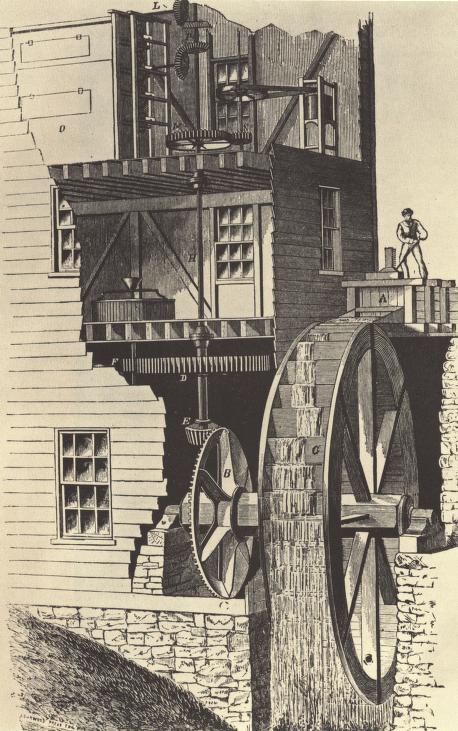|

(c) Pocumtuck Valley Memorial Association, Deerfield MA. All rights reserved.
Industry : Harnessing Water Power
|
|
By the eighteenth century, Europeans had depended for centuries upon mills. They were used to going to gristmills to grind their grain and to fulling mills to process wool cloth. Because virtually everyone had to have their grain ground, the gristmill became a natural gathering place for a community. Customers usually paid a miller with a proportion of the grain he ground for them. Millers and the mills they operated were a valuable community resource. Colonial settlements offered free land, water rights and other incentives to attract millers and their laborsaving machinery. Laws regulated the prices millers could charge for their services and protected other landholders from flooding and other potential problems a mill might cause.
Fast-moving streams powered early mills. A natural or man-made waterfall poured down the water that turned the waterwheel next to the mill building. The right amount of water was crucial. Too little water provided too little force to turn the wheel. Too much water in the millrace kept the wheel from turning. In a gristmill like the one pictured here, the wheel powered the millstones that ground the grain. One millstone, called the runner, turned on its side with another wheel, called the nether, beneath it. The miller fed the grain into a wooden hopper that released the grain to the wheels in a slow, steady stream. The two wheels ground the corn, wheat or rye between them. The miller adjusted the distances between the stones depending on the type of grain he was grinding. The grooves, or furrows, cut into the stones sliced off the outer husk of the grain. The furrows also allowed air to circulate between the stones. This prevented a dangerous buildup of heat from the constant friction the stones generated as they rubbed together. The actual grinding of the grain to flour occurred on the flat, or land, parts of the stones. Sharp furrows produced flour of a good, even consistency. Carelessly maintained stones ground coarse, lumpy flour that spoiled more rapidly.
A gristmill was a dusty place. Highly flammable chaff and flour dust filled the air. The miller used a wooden shovel; metal tools might strike a spark that could ignite a deadly explosion. The mill was also noisy. The whole building vibrated. Those inside the mill had to raise their voices to be heard above the roar of the water, the splashing of the water wheel, and the rubbing of the huge grindstones.
top of page
|
"Early American Mills"
| date 1973 |
| location New York |
| width 9.25" |
| height 12.0" |
| process/materials printed paper, ink |
| item type Art/Woodblock Print |
| accession # #L00.067ex |
|





